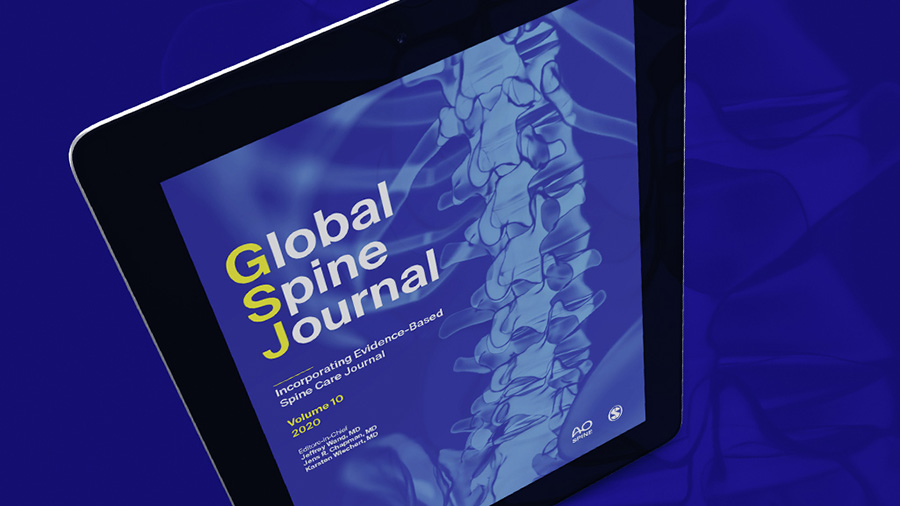Using post-operative drains in lumbar surgery—time for a rethink?
BY MATT GARY AND SO KATO, TOPIC LEADS JUAN CABRERA AND PATRICK HSIEH

Increasingly, research shows that the use of drains in post-operative lumbar surgery has few or no benefits—and may even have downsides. Yet a recent report from a collaborative project from AO Spine Knowledge Forums Deformity and Degenerative shows most surgeons worldwide routinely still use drains in post-operative care. Why are spine surgeons reluctant to change their practice? The study leads analyze the results of a global survey and the reasons behind.
If you regularly prescribe the use of wound drains for patients following lumbar spine surgery, despite growing evidence they may provide little or no benefit, you can take comfort in the fact that you are not alone.
In fact, according to our recent study on Surgeon Preferences Worldwide in Wound Drain Utilization in Open Lumbar Fusion Surgery for Degenerative Pathologies, over 80 per cent of surgeons worldwide routinely use wound drains following spinal fusion surgery to reduce the risk of infection, hematomas, and other postoperative complications.
The survey measured the responses of 280 practitioners across the globe, the majority (77%) of whom are orthopedic surgeons. The responses were then categorized according to geography, demographics, and experience.
And while there were some interesting differences between certain regions and age groups, our main finding is that the routine use of wound drains is still common across the world—with subfascial placement being favored by a large majority (73.2%) of the respondents who use them.
Does drain usage reduce surgical site infection or other complications after spinal surgery?
But the use of drains after lumbar surgery has become more contentious in recent years. Historically it was believed that post-operative drain placement helps to reduce the incidence of infection, seroma, and post-operative hematoma while also improving wound healing. However, the latest research has started to show conflicting results around the usage of wound drains in spinal surgery. For example, in their systematic review on drain utilization, Muthu et al (European Spine Journal, 2020) found that drain usage did not reduce surgical site infection or the risk of hematoma.
Another, more recent, randomized control study by The Spine Journal (Wound drain in lumbar arthrodesis for degenerative disease, 2023), aimed to evaluate wound drains in patients with lumbar arthrodesis for degenerative disorders based on clinical outcomes, complications, and length of stay. It analyzed outcomes among 93 patients and concluded that non-drain patients presented shorter length of stay and better outcomes than drain patients (while complication rates between the two groups were very similar).
Further, the survey advised: ‘Based on this study, in patients undergoing primary posterior spinal decompression and fusion up to three levels for degenerative lumbar disorders, we do not recommend the use of post-operative drains.’
Others have gone further to suggest that drain usage following lumbar spine surgery may be associated with a higher incidence of postoperative infections by allowing a conduit for microbial access and colonization into the wound. Drain placement may also increase hospital stays (Tan T, Lee H, Huang MS et al. Spine Journal 2020; Buser Z, Chang KE, Kall R etc. al, European Spine Journal 2022).
It was in response to these studies that we set out to discover what the current thinking is among surgeons and try to discover if there is a disconnect between what recent literature says about drain usage and its real-life practice in both spinal deformity and degenerative surgery.
Our study actually began as a survey to ascertain current practice around many aspects of post-operative management, including the use of antibiotics and braces as well as drain usage, and was initially confined to surgery in cases of spinal deformity. The scope later widened to include case of degenerative pathologies. Most of the questions were posed in multiple choice format, which is much better for data mining, although there was some opportunity for respondents to give further details. All respondents had to have performed at least 10 spinal surgeries in the previous 12 months.
Our key finding is that, despite all the recent literature suggesting that drain usage has no proven benefits, and potentially some downsides, current practice across the globe is to routinely use drains following lumbar spine surgery.
Why are surgeons wedded to using post-op drains in lumbar degenerative disease?
Perhaps one of the main reasons is that we surgeons tend to be risk averse, for obvious reasons. If you have been doing something since you were in training and doing it for 20 years, you’re going to need overwhelming evidence to convince you to stop doing it. Despite those recent studies, we simply don’t have the evidence to support just one post-operative practice.
Also, any new evidence should be taken with a grain of salt and reviewed on its own merits based on the biases, inclusion/exclusion criteria, and the resources available etc. For example, a lot of the evidence out there is from Europe and North America and may not actually be applicable to, say, Southeast Asia or vice versa.
The size of the study is also important. The study in the Spine Journal on wound drainage in lumbar degenerative disease did not show a benefit of drains and recommended against their usage in degenerative cases. But that was a study of 93 patients, which is not a large number, and it probably excluded specific types of patients. That’s to say, if a patient has a bleeding disorder, then you probably do want to use a drain, but those patients are probably going to be excluded from a study like this – no doctor is not going to put a patient into a randomized study if they have concerns. But randomized studies are the gold standard of research.
This is not to undermine the research; all research is valuable. But what is the incidence of hematoma? It’s very low already. A 2013 study on Postoperative Spinal Epidural Hematoma: incidence, risk factors, onset, and management by Amir Amiri, Ioannis Fouyas, Suzie Cro, and Adrian Casey looked at 4568 patients and found that the incidence of spinal epidural hematoma was just 0.22%.
Therefore, a study of 98 patients is not powered enough, even with the best methodology. It’s the same when it comes to studies on infections. The rate of infection is already very low, so you really must power your study to take that into consideration. With such small numbers it is not a surprise therefore, that so many surgeons are not convinced by current literature based on the methodology used.
The reluctance to change may also be a simple matter of training and education. Most medical students worldwide, including us, were taught about drain usage in medical school, and in our early years we also learned from our senior colleagues, mentors, and fellow residents. So, we simply copied them.
Wound drains have always been seen as a straightforward and trusted solution to prevent infection, hematoma and to manage complications. To suddenly stop using them takes some courage and could potentially open an individual surgeon up to blame—and legal action—if something goes wrong. One would need solid evidence for such a decision and, as discussed before, that concrete evidence does not currently exist.
Other facts such as culture probably also influence the decision to use drains even though increasingly there is no evidence of benefit. Our survey found that in Europe, Southern Africa, and the Asia Pacific, drain usage seems to be higher than in the US. This could be because those regions are more medically conservative – in Asia, for example, it’s traditional for patients to remain in hospital for much longer after surgery, perhaps one to two weeks (which may also have something to do with patient expectations).
By contrast, in the US lumbar surgery is frequently performed as a day surgery, in which case drain usage is not an option as most drains remain in place for up to 48 hours. Moreover, in the US there is often a desire simply to get patients out of hospital as quickly as possible and not just for cost reasons (although insurance and reimbursement do play their part).
Post-operative exercise and movement is important to reduce disability and pain following lumbar fusion surgery. There is some evidence that drain usage can lead to decreased movement and delays in healing, not because the drain itself hampers movement but because patients are much more cautious, and potentially uncomfortable, if a drain has been inserted.
If drain utilization reduces early mobilization, this can lead to a higher rate of medical complications such as pneumonia, deep vein thrombosis and other infections.
Despite this, and although research suggests a correlation between drain utilization and increased hospital stays, our study shows that even in countries where there is a push to reduce length of hospitalization, wound drain utilization is still high.
This suggests that surgeons still strongly believe that not using a drain will increase the risk of hematoma, seroma and infection and consequently increase the risk of rehospitalization and re-operation with all its associated costs and complications.
When to remove drains after spinal surgery?
But it isn’t just in the use of wound drains where we see discrepancies between literature and practice—even among those who routinely used wound drains in our study, there was little consensus over when to remove them. The most significant predicting factor for drain removal based on duration versus removal based on output was the surgeons’ region of practice and experience. In the Asia Pacific, Europe and Latin America, the duration of the drain was the determining factor for removal (typically the second post-operative day), as opposed to the US where drain output was seen as more important.
Anecdotal evidence suggests that in Asia, drain removal based on output is seen as ‘old school’ and that leaving a drain in place for longer than the second post-operative day dramatically increases the risk of infection—plus it is unnecessary since the likelihood of a hematoma at this point is statistically small. However, among the entire global survey group, younger surgeons (those with less than five years’ experience) were also more likely to remove drains based on output rather than duration. We don’t really know the reasons for this and it’s an area worth investigating further.
In fact, many aspects of our study are worth investigating further. What we do know is that despite mounting evidence that wound drains do little to prevent hematomas or infections, and can lead to longer hospital stays, the overwhelming majority of surgeons globally still use them in post-operative spinal fusion surgery. And the main reason for this is that surgeons are not convinced that the latest research is thorough or concrete enough to persuade them to rethink their own personal experience. (Full disclosure: we are also part of this group because as practicing surgeons we also routinely use wound drains post lumbar surgery in both degenerative and deformity cases.)
Time for a rethink?
So, what would persuade us and other surgeons to rethink our practice regarding drain utilization? Well, the easy answer is more comprehensive research into the outcomes of drain vs non-drain usage and an established set of guidelines.
That is an easy answer but not necessarily a simple one. For instance, how wide would that research have to be? Given how low infection rates and hematomas already are, if you take 1000 patients and you compared drain versus no-drain, there’s every chance you would not encounter a single blood clot in either group. And we fully admit that even our survey has limitations—we asked over 6000 surgeons to take part but the response rate of 280 was low, so the sample size potentially limits the validity of the findings. We also didn’t analyze other peri-operative factors such as blood loss, surgical duration, neurological status, patient-reported outcomes etc.
In conclusion, the latest research into the lack of benefits around wound drain usage is persuasive but not definitive. This explains why many of us are reluctant to change our practice—we were trained to use wound drains, we have always used wound drains, we know our rates of infection, our post-op hematoma rates and so we would need a compelling reason to stop doing something we believe to have worked for so long.
Longer term, what is needed is more research—and more discussion—around wound drainage in lumbar fusion surgery, both in degenerative and deformity conditions. If it can be definitively proven that sub-fascia drainage has no post-operative benefits, that the negatives indeed outweigh the positives—and proper guidelines and protocols can be established around that—then everyone will feel more confident changing current practice. Until then, we’ll probably all continue doing what we’ve always done no matter what the literature says .
About the authors:
Matthew Gary, MD FAANS is an Associate Professor of Neurosurgery at Emory University Hospital in Atlanta, GA where he practices complex and minimally invasive spine surgery. He is also the Associate Residency Program Director of neurosurgery at Emory. He has been an active member of the AO Spine Knowledge Forum Degenerative.
Juan P. Cabrera, MD. Associate Professor of Neurosurgery at University of Concepción, Chile. Founder of the Intraoperative Neurophysiological Monitoring Unit of his Hospital. His career is focused on complex spine surgery, with special interest in the craniovertebral junction, trauma, and degenerative disorders. Associate Member of the AO Spine Knowledge Forum Degenerative, and Committee Member of the Section on IONM at NASS. Succesful candidate of the first generation of AO Spine Global Diploma Exam. Member of AO Spine Latin America Trauma Study Group, and Education Officer (Neuro) AO Spine Chile.
Patrick C. Hsieh, MD, MS, MBA, is the Edwin M. Todd/Trent H. Wells, Jr. Professor of Neurosurgery at the University of California located in Los Angeles, CA. He specializes in complex spine surgery with a particular focus on spinal oncology and spinal deformity. He also has expertise in minimally invasive spine surgery. Dr. Hsieh is an active member of various professional organizations, including AO Spine, NASS, SRS, AANS, and CNS. He serves as a steering committee member of the AO Spine Knowledge Forum Degenerative and is a board of directors at NASS. He also chairs the NASS International.
About the study:
POMA—Intra- and Postoperative Management of Adult Spine Deformity or Degeneration Patients—is a collaborative study conducted by the AO Spine Knowledge Forums Deformity and Degenerative. A perioperative survey created by AO Spine experts in the KFs was distributed via email to AO Spine users and members between March 3–22, 2022. The questionnaire included demographic information on participants and was designed to cover various aspects of peri-operative care such as wound management, antibiotics, bracing, and activity instructions. 280 surgeons completed the survey, among them 164 surgeons who performed adult spinal deformity surgeries and 261 surgeons performing adult spinal degenerative surgeries.
You might also be interested in:
AO Spine Knowledge Forums (KF)
Creating new knowledge to make your patients and practice flourish.
Courses and events
Find all upcoming courses and events on lumbar pathologies and approaches.
Global Spine Journal
AO Spine’s official scientific journal, the first fully open access journal in the field of spine surgery with an Impact Factor.








